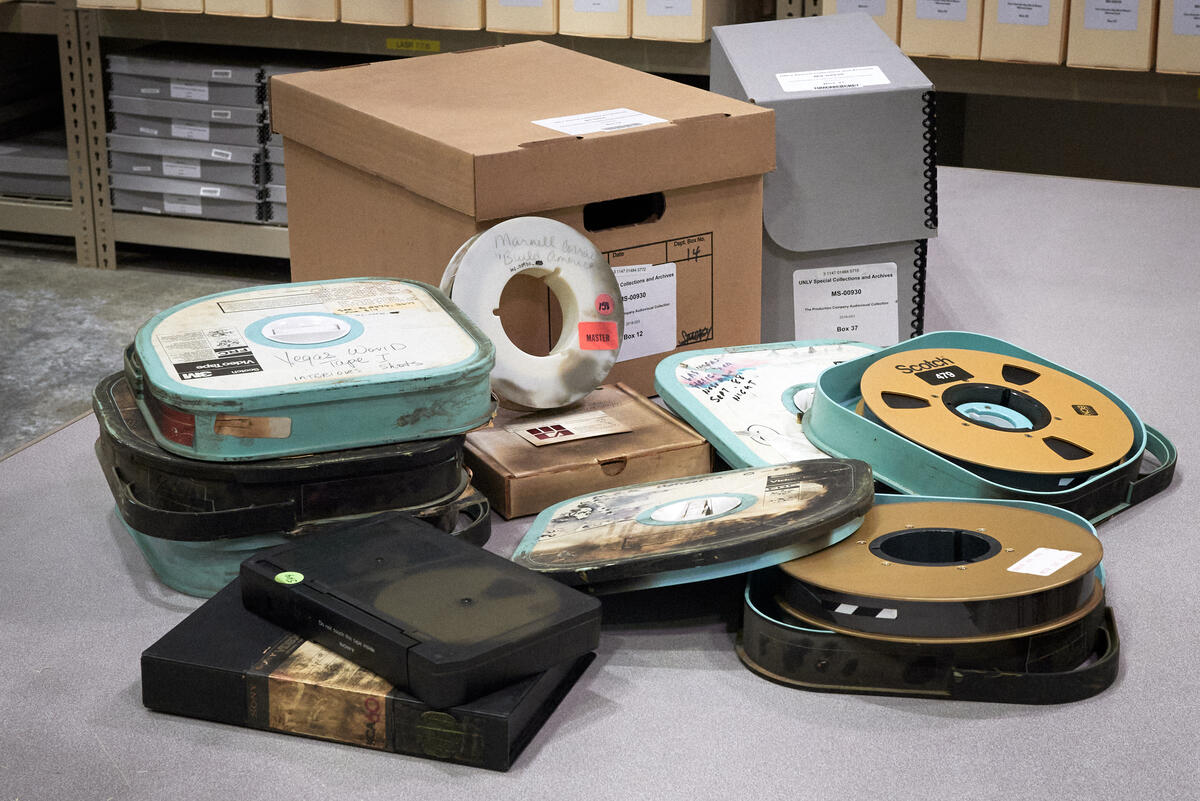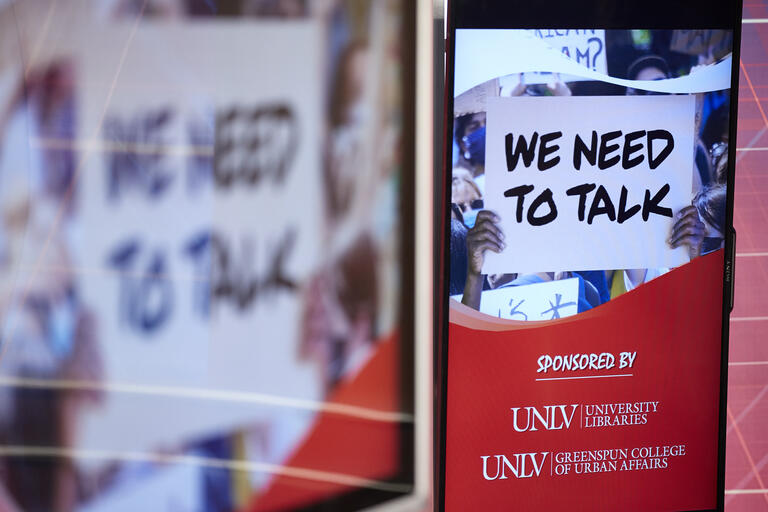More than 800 unique videos chronicling the lives of Las Vegas casino workers have been revitalized through a recent digital preservation project by UNLV Special Collections and Archives.

The digitization work on “Doubling Down: Preserving the Stories of the Workers and Dreamers Behind the Las Vegas Casino Industry” was made possible by a Recordings at Risk Grant from the Council on Library and Information Resources.
The project was one of 17 selected for funding during this cycle of the Recordings at Risk grant program. With generous funding from the Mellon Foundation, Recordings at Risk grants support the preservation of rare and unique audio and audiovisual content of high scholarly value.
“By digitizing these videos, we have enhanced their accessibility for modern users, bringing to life the stories they contain while adding rich visual and audio context to the Las Vegas historical narrative,” said Sarah Quigley, director of Special Collections and Archives.
Tapes popular in the pre-digital age degrade over time, leading to diminished image and sound quality or total loss of content. Additionally, many of these tapes suffered from environmental damage; one collection survived severe fire damage.
“The materials these tapes are made of have become obsolete,” said Quigley. “And the more you play them, the faster you degrade the materials. That’s why we require these videos to be digitized prior to use, so the content can be preserved for future researchers.”

The project digitized a total of 846 videos from a number of archival collections, spanning Las Vegas from the 1960s to the 2010s. Roughly 450 of those videos are now available online, and the remaining files are available in the Special Collections and Archives Reading Room in Lied Library and virtually upon request.
Sarah Jones, head of Special Collections and Archives Technical Services, led this grant-funded project and has selected several historically significant video clips to showcase the variety of digitized content.
"Titanic Resorts Inc." press conference and announcement
In 1999, Stratosphere founder Bob Stupak announced his vision for a Titanic-themed casino and resort on the Las Vegas Strip. This video includes Stupak describing how he will be "raising Titanic on the Strip" just north of the Stratosphere, and concludes with Robert Goulet performing a song about the Titanic. The proposed 15-story hotel, complete with an iceberg, was to include fine dining, showrooms, and entertainment, but ultimately scuttled by concerns from the Las Vegas City Council and financial constraints.
Materials on proposed resorts offer researchers valuable insights into economic and development trends, cultural and social changes, architectural and design history, and the evolving nature of the gambling and tourism industry.
From the Bob Stupak Professional Papers (MS-01016)
"MGM Pickets" footage of workers on strike
The Culinary Workers Union Local 226 is one of the largest labor unions in Las Vegas, demanding better wages, job security, and safer working conditions for its members. The union’s history of striking is well documented, including in this video of workers outside the MGM. This type of documentation provides valuable perspectives on labor movements, social dynamics, and historical events.
Part of The Production Company Audiovisual Collection (MS-00930).
Stardust Resort and Casino Lido de Paris original transfer master
This 1988 video features b-roll of dress rehearsals for the Allez Lido, the 12th and final edition of the Lido de Paris show at the Stardust Hotel, with segments showcasing ice skating, showgirls and dancers with fans, and well-known and controversial animal trainer Bobbi Berosini performing with an orangutan.
The Lido de Paris, which debuted at the Stardust in 1958, was a glamorous and extravagant homage to the original Parisian show, playing a pivotal role in establishing Las Vegas as a global center for entertainment. The long-running Vegas showgirl production became an iconic symbol of the city, synonymous with luxury and spectacle.
The 31-minute video provides a behind-the-scenes look at one of Las Vegas’ most iconic and enduring showgirl productions.
Part of the Stardust Resort and Casino Records (MS-00515).
"Let's Go A-Go-Go" act performing on the Strip and Caesars Palace under construction
Las Vegas in the 1960s was a rapidly growing city, quickly solidifying its reputation as a premier destination for entertainment and gambling. This 1966 video documents a pivotal time of expansion, highlighted by the construction of the iconic resort Caesar’s Palace, which brought a touch of grandeur to the Strip.
The video features performers from "Let's Go A-Go-Go" touring Las Vegas, including a tour of the under-construction Caesars Palace with founder Jay Sarno. The video also includes footage of the Hacienda Hotel and Casino Horse and Rider sign, The Sands, The Sahara, views from The Dunes, the Flamingo, Thunderbird Casino, and The Riviera.
The video offers a rare glimpse at the growth of a glittering gambling mecca defined by neon signs and glamorous entertainment.
From The Production Company Audiovisual Collection (MS-00930)
Inside the “count room” at Circus Circus
The casino count room is highly secure and secretive by nature, where large sums of money from the casino floor are counted, sorted, and verified. This video from the 1980s offers a rare behind-the-scenes glimpse of the coin count room at Circus Circus, with an employee loading coins into a counting and wrapping machine.
From The Production Company Audiovisual Collection (MS-00515)
Penelope Ruchman Collection of Las Vegas, Nevada Casino Professionals Oral Histories
Penelope “Pennie” Ruchman is a longtime gaming and casino professional who worked at the Gambler’s Book Shop near downtown Las Vegas. From 1999 to 2001, she conducted nearly 100 oral history interviews with Las Vegas casino industry workers from the shop’s office.
The recordings of these interviews, intended to be a definitive historical compilation of early casino industry workers, were donated to Special Collections and Archives in 2018. Though not available online, the newly digitized recordings feature interviews with notable individuals such as Jim Seagrave, Anthony Curtis, Claudine Williams, Joe Lupo, Stanford Wong, Frank “Lefty” Rosenthal, and more.
From the Penelope Ruchman Collection of Las Vegas, Nevada Casino Professionals Oral Histories (MS-00907).
B-roll of UNLV campus, Bishop Gorman High School, Church, Wedding chapel, slot shop, signs, and Thunderbird Hotel.
Established in 1992, UNLV TV has served as the professional television production unit for the university, and has provided hands-on broadcast and production training for thousands of students in the Greenspun College of Urban Affairs while documenting life at UNLV and in Las Vegas.
This 1995 video showcases the “Soul Festival” at the Valerie Pida Plaza and Alumni Amphitheater, as well as images of buildings around the city.
From the UNLV TV Audiovisual Collection (UA-00098).



